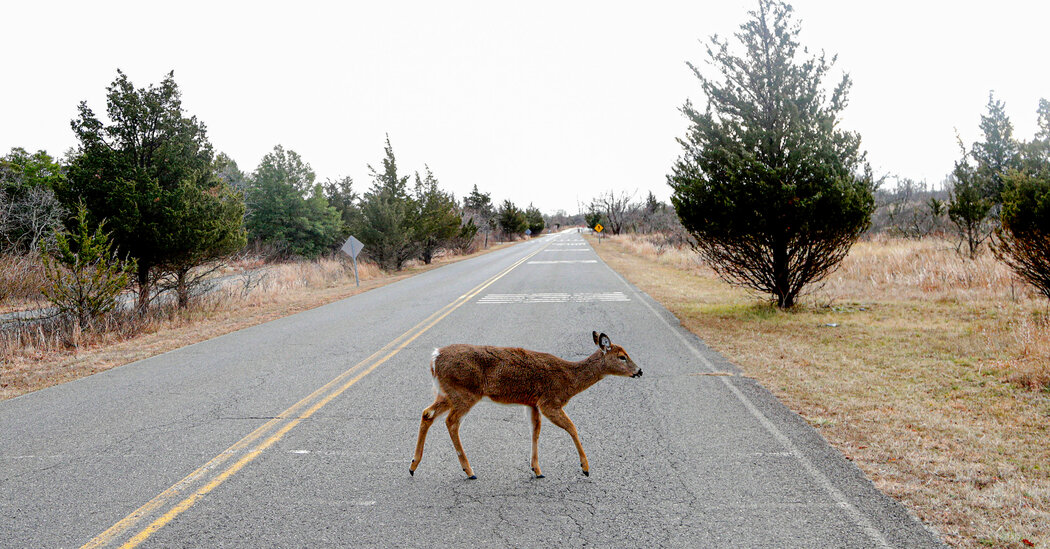
Scientists have identified a new, highly mutated version of the coronavirus in white-tailed deer in southwestern Ontario, one that may have been evolving in animals since late 2020.
They also found a very similar viral sequence in one person in the area who had close contact with deer, the first evidence of possible deer-to-human transmission of the virus.
“The virus is evolving in deer and diverging in deer away from what we are clearly seeing evolving in humans,” said Samira Mubareka, a virologist at Sunnybrook Research Institute and the University of Toronto and an author of the new paper.
The report has not yet been published in a peer-reviewed journal, and there is no evidence that the deer lineage is spreading among, or poses any elevated risk to, people. Preliminary laboratory experiments suggest that the lineage is unlikely to evade human antibodies.
But the paper was posted online just days after another team reported that the Alpha variant may have continued to spread and evolve in Pennsylvania deer even after it disappeared from human populations.
Together, the two studies suggest that the virus may be circulating among deer for extended periods of time, raising the risk that the animals could become a long-term reservoir of the virus and a source of future variants.
“There’s certainly no need to panic,” said Arinjay Banerjee, a virologist at the University of Saskatchewan who was not involved in either study.
But, he added, “The more hosts you have, the more opportunities the virus has to evolve.”
Previous studies have found that the virus is widespread in white-tailed deer. Research suggests that humans have repeatedly introduced the virus to deer, which then transmit it to one another. How humans are spreading the virus to deer remains a mystery, and until now, there has been no evidence that the animals are passing it back to humans.
The Canada study was a collaboration involving more than two dozen researchers at institutions across Ontario. The scientists collected nasal swabs and samples of lymph node tissue from 300 white-tailed deer killed by hunters in Ontario between Nov. 1 and Dec. 31, 2021. Six percent of the animals, all from southwestern Ontario, tested positive for the virus, suggesting that they were actively infected when they died.
The researchers sequenced the full viral genomes from five infected deer and found a unique constellation of mutations that had not been previously documented. Overall, 76 mutations — some of which had previously been found in deer, mink and other infected animals — set the lineage apart from the original version of the virus.
The deer samples were most closely related to viral samples taken from human patients in Michigan, not far from southwestern Ontario, in November and December 2020. They were also similar to samples taken from humans and mink in Michigan earlier that fall.
Those findings, as well as the rate at which the virus accumulates mutations, suggest that the new lineage may have diverged from known versions of the virus, and been evolving undetected, since late 2020.
But its precise path is unclear. One possibility is that humans might have passed the virus directly to deer, and the virus then accumulated mutations as it spread among the cervids. Alternately, the lineage may have evolved at least partly in another, intermediate species — perhaps farmed or wild mink — which then somehow transmitted it to deer.
“We don’t have all the pieces in the puzzle,” Dr. Suresh Kuchipudi, a veterinary microbiologist at Penn State, who was not involved in the research, said in an email. “We cannot rule out the involvement of an intermediate host.”
A viral sample collected from one human patient in southwestern Ontario in the fall of 2021 closely matched the deer samples. That person is known to have had “close contact” with deer, the researchers said.
(They could not disclose more details about the nature of this contact for privacy reasons, although Dr. Mubareka noted that people should not worry about incidental, indirect encounters, like simply having a deer wander through their backyard.)
The sample size is tiny, scientists cautioned, and there is no conclusive proof that the person caught the virus from deer. “We don’t have enough information yet to confirm that transmission back to humans,” said Roderick Gagne, a wildlife disease ecologist at the University of Pennsylvania School of Veterinary Medicine.
But at the time the human sample was collected, Ontario was sequencing samples of the virus from everyone in the region who tested positive on a P.C.R. test. The researchers did not find any other people who had been infected by similar versions of the virus, making it less likely that it evolved independently in humans.
“Had it been circulating widely in humans, even narrowly in humans, I think we would have picked it up,” Dr. Mubareka said.
There is also no evidence that the person infected with the lineage passed the virus on to anyone else.
The Coronavirus Pandemic: Key Things to Know
Vaccine protection in adolescents. Five months after immunization, two doses of the Pfizer vaccine appeared to offer virtually no defense against moderate illness caused by Omicron among adolescents aged 12 to 17 years, according to new C.D.C. data. Booster shots, however, dramatically increased the protection.
And early data suggest that existing vaccines should still be able to protect against the lineage. Antibodies from vaccinated people were able to neutralize pseudoviruses — harmless, nonreplicating viruses — that had been engineered to resemble the deer lineage, the scientists found.
In the second study, scientists from the University of Pennsylvania’s veterinary and medical schools analyzed nasal swabs from 93 deer that died in Pennsylvania in the fall and winter of 2021. Nineteen percent were actively infected with the virus. When the researchers sequenced seven of the samples, they found that five of the deer were infected with the Delta variant, while two were infected with Alpha.
At the time the samples were collected, Delta was widespread among the human residents of the United States, but the Alpha wave that hit Americans in the spring of 2021 had long since faded.
“Alpha seems to be persisting in the white-tailed deer even during the time when it’s not circulating in humans,” said Eman Anis, a microbiologist at the University of Pennsylvania School of Veterinary Medicine and an author of the study.
Indeed, the Delta samples in deer were genetically similar to those from humans, suggesting that it had crossed species lines relatively recently. But the two Alpha sequences had diverged more significantly from human lineages. (They were also substantially different from each other, suggesting that the variant had been introduced to the deer population at least twice.)
“The main implication would be that the deer sustain transmission and infections within their populations,” Dr. Gagne, an author of the Pennsylvania study, said. “So that is not just, you know, a spillover event from humans, deer get infected and then it fizzles out.”
Whether these lineages will continue to circulate and evolve in deer is unknown, as is the risk they may pose to humans and other animals.
“Based on current information, I’d say that the risk of wildlife, including deer, spreading the virus to people is low,” said Jeff Bowman, a research scientist at the Ontario Ministry of Northern Development, Mines, Natural Resources and Forestry and an author of the Canada paper.
But ongoing surveillance is critical, scientists said. Dr. Mubareka suggested that officials should enhance wastewater screening in Ontario and other nearby regions to look specifically for the deer lineage — and to ensure that it is not becoming more prevalent.
Experts also urged people to continue to follow guidelines put out by public health agencies, including not feeding deer or other wildlife and wearing gloves while butchering game.
“We should also be reducing the biggest reservoir for this virus, which is us,” Dr. Mubareka said, “to make sure we’re not continuously spilling into deer and creating these new lineages.”




